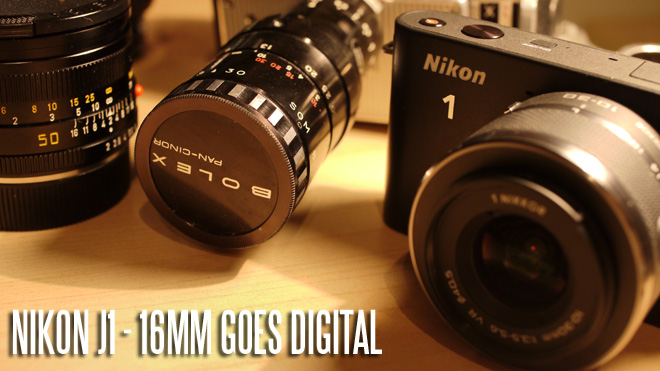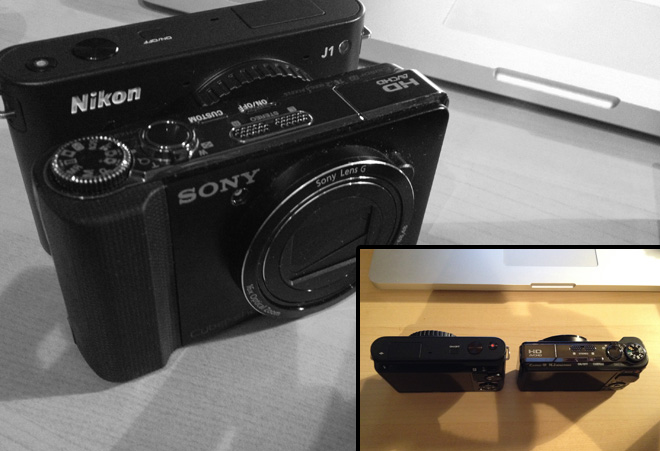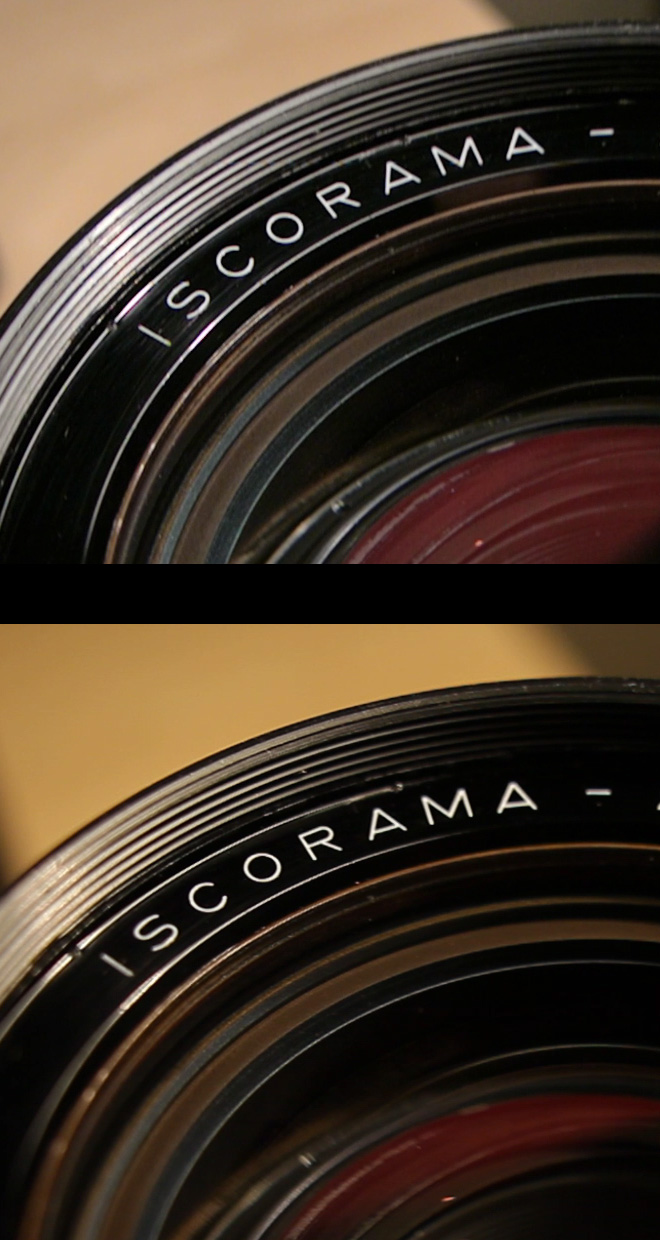
EOSHD takes a first look at the Nikon J1
If you are doing personal work as a lone artist the Nikon J1 might be of interest. Whilst many filmmakers quite reasonably would think of this thing as a toy, creatively it does have a purpose and there’s also some interesting technology in it.
The J1 is the first outing of Nikon’s extremely fast Expeed 3 chip (a beefed up version of this appears in the new Nikon D4!)
When the J1 and V1 were revealed I was not that impressed. Didn’t like the small sensor. Didn’t like the build. Didn’t like the lack of 24p and I thought it was a shame to see Nikon squander so much of their future camera technology on such a cheap consumer point and shoot.
Because lets face it – soon mirrors and optical prisms will be replaced with electronics across the board like on the GH2 and J1, so DSLRs will give way to mirrorless mounts and EVFs, which is far better for video.
As it turns out, the Nikon J1 actually does have a few tricks up its sleeve. For a start it really is tiny. The body is the size of a compact (it is a Sony HX9v in the image below) and with a adapted c-mount lens or Nikon CX pancake you’ll have the most compact interchangeable lens 1080p video camera in the world.

When a small sensor is actually an advantage
The sensor in the J1 is a 2.7x crop, and roughly equivalent to a Bolex 16mm camera from the 70’s and the same as the 1080p 1:1 crop mode on the Nikon D4.
There is far more to a shallow depth of field than meets the eye and a lot of misconceptions out there. First and foremost it makes sense for a filmmaker to have choice. Small sensor, large sensor. It is not that one is better than the other. It is that they have different uses.
With a large sensor, if you are doing a close up in low light with a fast aperture and 50mm portrait lens, the focus plane is going to be incredibly narrow to the point where an actor’s eyes will be in focus but their ears won’t. If you don’t want this look or if your actor is moving around and you try to do a close up like that, focussing will be impossible and you’ll need to stop down for a more manageable depth of field rather than actors going in and out of focus through a millimetre wide focus plane – the classic DSLR video cliche.
For a low light close up the small sensor in the J1 has an advantage because it will allow enough shallow DOF to be attractive but not too much to make focussing impossible and you don’t need to stop down to F5.6. You can stay at a fast aperture for better low light abilities. 18mm on the J1 is similar to the field of view of a 50mm on full frame, and the wider focal length helps to keep DOF more manageable at a fast aperture. The camera is a great match to high quality vintage c-mount 16mm lenses like those from Kern Switar, even a 10mm F1.8 might cover the J1’s sensor without vignetting.
When you are shooting a subject which is further away, say 3m from the lens full frame has an advantage because it maintains a relatively shallow DOF where on the J1 it would look rather flat. The 5D Mark II can do a shallow DOF at wide angle as well which can be an interesting look (i.e. at 24mm F1.4).
So to summarise:
- Mid shot with standard 50mm lens – full frame has the advantage
- Close-up in low light with fast aperture – J1 can be useful to achieve a manageable DOF
Noise
Keeping the sensor at 10MP was a good choice by Nikon and it means ISO performance, although not world beating, is not a complete disaster. Nikon just don’t seem to be interested in the mega pixel race at the moment and the Nikon D4 is only 16MP. Very good news.
The noise grain is not too bad – reasonably fine and organic looking given the price tag and standard video compression rate (24Mbit). On the J1 although ISO 1600 is not as clean as on the GH2 or 5D Mark II at 44Mbit+ it is certainly usable, and as always with a CMOS sensor the noise goes away on adequately exposed / illuminated areas of the image and is more noticeable in dim areas of an image.
A picture profile has a lot to do with what is resolved in the lows and mids as well.
Never judge ISO performance from a brightly lit still life scene. So many reviews out there still do this!
Resolution, moire, aliasing and rolling shutter
Resolution is just about on the 5D Mark II level in video mode but for cleanness of detail it is better. The more powerful (and 3 years newer) Expeed 3 image processor can do a more complex job of scaling the sensor than the 5D Mark II. As well as that the sensor is only 10MP so there is less data there to bin in the first place.
On a macro shot like that below, or for head and shoulder close-ups of an actor, resolution is fine but it is more challenged for wide angle architecture and vistas.
Top – Nikon J1. Bottom – 5D Mark II

However the Nikon J1 has some odd artefacts of its own, some of which are very odd indeed. For example a sheering of patterns where one part of the texture seems cut off from the rest. For the usual moire it is a bit better than on current Canon DSLRs but aliasing is about the same.
The sensor has some high speed capabilities so it has a very fast data readout along with a small physical size which means rolling shutter is at minimal Sony F3 / Canon C300 levels especially at 1080/60i and 720/60p. A very impressive performance here.
A good candidate for hacking
Vitaliy Kiselev has been helping to crack the encryption on the Nikon D5100. A hack for the J1 would be more interesting because the low level stuff – which can’t be hacked – is more soundly implemented than on the older Nikon D5100 (for example better image scaling from the full sensor). This early Nikon hacking may eventually lead to the J1. We’ll just have to wait and see.
The negatives
Some quirks on the J1 would benefit from being hacked out.
The minimum shutter speed is 1/100 for PAL users.
This is because the J1 has no 25p or 50p mode, but a 50hz flicker reduction option in the menus. With this enabled, the minimum shutter speed is a rather high 1/100. Without it enabled, the minimum is 1/60 but that causes strobing under 50hz lighting in PAL countries. Nikon really shortchanged PAL users here. The GH2 can do 1/50 and even 1/25 for a nice exposure gain in low light. With the J1 if you have 50hz electric lights in your shot, 1/100 is your lot! So PAL users be sure to pack a fast lens under night time street lights and dim interior light.
There’s no 24p – well not really. The high speed shooting mode which does 1080/60p is slowed to 24p slow motion but only records for 1 second (output is around 2 seconds) so I’d be inclined not to use that and instead go for Twixtor instead in post.
The bitrate in 1080/60i/30p mode is 24Mbit, the same as the out of the box GH2. This is OK and doesn’t represent a major issue since Nikon’s Expeed 3 does a good job of encoding with very little mud. But it would be nice to see higher bitrates which give you more fine details in highly detailed scenes and a finer noise grain.
Audio
Unfortunately the J1 doesn’t have an external mic socket. It does however have the ability to turn off auto-gain-control (AGC) and select one of 3 sensitivity levels for the built in a mic.
HDMI output
The Nikon J1 didn’t work well with the Zacuto EVF, I just couldn’t get an image. On a computer monitor with HDMI I did get an image but it wasn’t a very good one. It stays on whilst recording but cuts off on the camera. Resolution didn’t seem at the 1080p mark although a 1080 signal of some sort was being output.
It isn’t in the least bit clean, there are icons all over the place! Camera settings don’t get rid of them. There’s also a black border around the image. There’s no gamma or colour-space shift when you hit record though, like there is on the GH2 and NEX 5N.
Who is it for?
- Video artists (experimental work, personal project or where a specific look is needed that the J1 and a certain lens delivers)
- Discrete filming (stealth filming on location where pro video cameras are not allowed)
- Shoots where a very small and light camera is more practical than a large heavy one
- Documentary run & gun where getting the shot is a priority over LOG, 10bit, ultimate image quality, etc.
- Shots where a fast aperture but manageable depth of field is required (for example action sequences in low light)
- Travel footage and video blogging
- Freelance videographer on a budget
- Point & shoot / compact replacement, with respectable AF and full-auto in video mode
Who isn’t it for?
- Commercial filmmakers on a spec shoot for a client
- Commercial crews
- Event shooting or weddings where discrete high quality onboard audio is needed
- Shots for where the aesthetic look of a 2.7x crop sensor isn’t as desirable as full frame or Super35.


